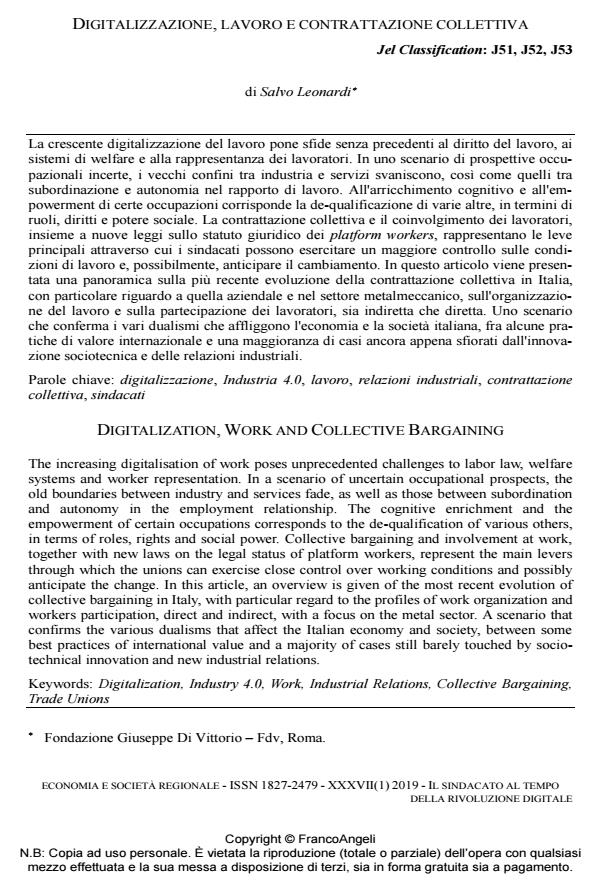Digitalization, work and collective bargaining
Journal title ECONOMIA E SOCIETÀ REGIONALE
Author/s Salvo Leonardi
Publishing Year 2019 Issue 2019/1
Language Italian Pages 15 P. 46-60 File size 286 KB
DOI 10.3280/ES2019-001005
DOI is like a bar code for intellectual property: to have more infomation
click here
Below, you can see the article first page
If you want to buy this article in PDF format, you can do it, following the instructions to buy download credits

FrancoAngeli is member of Publishers International Linking Association, Inc (PILA), a not-for-profit association which run the CrossRef service enabling links to and from online scholarly content.
The increasing digitalisation of work poses unprecedented challenges to labor law, welfare systems and worker representation. In a scenario of uncertain occupational prospects, the old boundaries between industry and services fade, as well as those between subordination and autonomy in the employment relationship. The cognitive enrichment and the empowerment of certain occupations corresponds to the de-qualification of various others, in terms of roles, rights and social power. Collective bargaining and involvement at work, together with new laws on the legal status of platform workers, represent the main levers through which the unions can exercise close control over working conditions and possibly anticipate the change. In this article, an overview is given of the most recent evolution of collective bargaining in Italy, with particular regard to the profiles of work organization and workers participation, direct and indirect, with a focus on the metal sector. A scenario that confirms the various dualisms that affect the Italian economy and society, between some best practices of international value and a majority of cases still barely touched by sociotechnical innovation and new industrial relations.
Keywords: Digitalization, Industry 4.0, Work, Industrial Relations, Collective Bargaining, Trade Unions
- The variable geometry of bargaining: implementing unions' strategies on remote work in Italy Anne-Iris Romens, Valeria Piro, Francesco E. Iannuzzi, in STUDI ORGANIZZATIVI 1/2022 pp.129
DOI: 10.3280/SO2022-001006 - Relazioni industriali e nuove tecnologie: conflitto, partecipazione e concertazione nell'era del lavoro digitale Matteo Turrin, in ECONOMIA E SOCIETÀ REGIONALE 3/2022 pp.55
DOI: 10.3280/ES2022-003006
Salvo Leonardi, Digitalizzazione, lavoro e contrattazione collettiva in "ECONOMIA E SOCIETÀ REGIONALE " 1/2019, pp 46-60, DOI: 10.3280/ES2019-001005